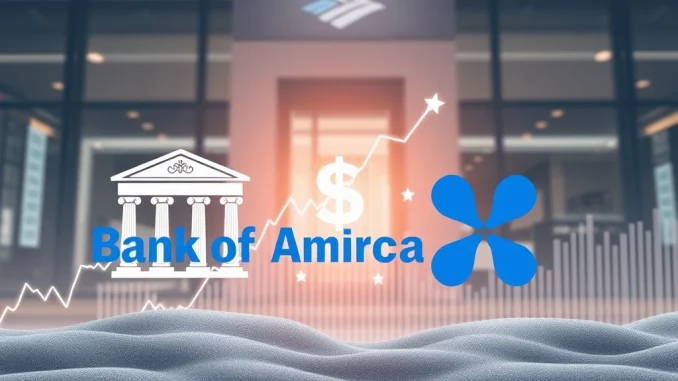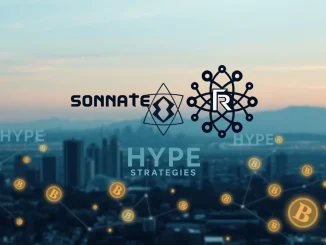
In a groundbreaking development shaking up the cryptocurrency world, the latest XRP News indicates that Bank of America (BAC) is reportedly evaluating the integration of Ripple’s innovative RLUSD stablecoin into its expansive financial services. This strategic consideration comes as RLUSD itself experiences a phenomenal surge, its market capitalization climbing by over 30% to exceed $517 million, all set against a backdrop of significant regulatory shifts favoring digital assets. This move by a major traditional financial institution like Bank of America could mark a pivotal moment for the widespread adoption of stablecoins and the broader digital economy.
Bank of America’s Strategic Dive into Ripple RLUSD
Bank of America, a global banking giant, is reportedly eyeing Ripple’s RLUSD stablecoin, signaling a profound shift in how traditional finance views and adopts digital assets. This isn’t a sudden interest; the bank has been exploring dollar-backed stablecoins for cross-border settlements and liquidity management since as early as 2019. Their long-standing collaboration with Ripple, which includes leveraging Ripple’s technology for real-time gross settlement systems, positions RLUSD as a prime candidate for integration into future digital dollar initiatives.
But why now? The current environment, characterized by evolving U.S. regulatory frameworks and burgeoning institutional demand for digital assets, makes the timing particularly ripe. Ripple CEO Brad Garlinghouse has consistently emphasized RLUSD’s institutional-grade compliance as a core differentiator. This focus on regulatory adherence and security is precisely what appeals to banks like Bank of America, which prioritize secure and compliant digital solutions to mitigate risks inherent in the nascent crypto space.
- Strategic Alignment: Integration aligns with BAC’s long-term exploration of digital currencies for efficiency.
- Institutional Demand: Acknowledges the growing appetite among financial institutions for reliable digital asset solutions.
- Compliance Focus: RLUSD’s emphasis on regulatory approvals makes it an attractive, low-risk option for a major bank.
The Phenomenal Surge of Ripple RLUSD: What’s Driving Its Growth?
The recent growth trajectory of RLUSD is nothing short of impressive. The stablecoin has not only surged over 30% in value but has also surpassed $500 million in circulation. This significant expansion underscores its burgeoning institutional potential and growing market confidence. Several key factors contribute to this rapid ascent:
- Regulatory Compliance: RLUSD’s compliance with the New York Department of Financial Services (NYDFS) standards is a major confidence booster. New York is a critical financial hub, and meeting its stringent regulatory requirements signifies a high level of trustworthiness and operational integrity.
- Multi-Chain Operability: The stablecoin’s capability to operate across both the XRP Ledger (XRPL) and the Ethereum blockchain offers unparalleled flexibility. This dual-chain functionality addresses institutional concerns around liquidity, enabling seamless transactions and asset transfers across different ecosystems, thereby expanding its utility and reach.
- Custodial Backing: BNY Mellon’s role as a custodian further strengthens RLUSD’s credibility among traditional financial players. BNY Mellon is one of the oldest and largest financial institutions globally, and its involvement provides an added layer of security and trust, crucial for attracting large-scale institutional investment.
Unlike many algorithmic stablecoins that have faced scrutiny and even collapse due to their complex and often volatile mechanisms, RLUSD’s fully collateralized structure reduces exposure to liquidity crises. This design, where each RLUSD token is fully backed by U.S. dollars, provides a stable and predictable value, a critical factor for risk-averse institutional investors wary of past failures like TerraUSD. Ripple’s commitment to transparency, including regular audits and real-time reserve tracking, further solidifies its appeal, fostering an environment of trust that is paramount in the digital asset space.
Navigating the Evolving Regulatory Landscape for Stablecoin Integration
Regulatory clarity has been a pivotal force in fostering institutional interest in stablecoins. The newly enacted GENIUS Act, for instance, provides a comprehensive framework for stablecoin regulation, significantly reducing uncertainties for banks like Bank of America. This legislation offers a clearer path for financial institutions to engage with digital currencies without navigating a murky legal landscape, which has historically been a major deterrent.
Ripple’s proactive approach to securing regulatory milestones has also expanded RLUSD’s global reach and mitigated risks for institutional clients. In May 2025, the stablecoin secured approval from the Dubai Financial Services Authority (DFSA), marking a significant endorsement for its deployment in the Middle East, a rapidly growing market for digital finance. Such certifications are crucial as they:
- Mitigate Risk: Reduce perceived regulatory and operational risks for institutional clients.
- Build Trust: Provide official endorsements that validate the stablecoin’s compliance and operational standards.
- Expand Market Access: Open doors to new jurisdictions and larger pools of institutional capital.
This commitment to regulatory alignment positions RLUSD as a secure and reliable option, contrasting sharply with the historical caution institutions have shown towards stablecoin volatility and regulatory ambiguity. The emphasis on robust compliance and transparent operations makes RLUSD an attractive proposition for banks looking to venture into the digital asset space responsibly.
The Broader Impact: Reshaping the Future of Digital Assets
The potential partnership between Bank of America and Ripple aligns with broader, transformative trends in fintech and the global financial ecosystem. As central banks and regulators increasingly acknowledge digital currencies as powerful complements to traditional financial systems, institutions are prioritizing collaborations with firms that skillfully balance innovation with strict regulatory alignment. This paradigm shift is not just about adopting new technology; it’s about integrating digital solutions into existing frameworks to enhance efficiency, reduce costs, and improve accessibility.
Despite Ripple’s ongoing navigation of U.S. Securities and Exchange Commission (SEC) litigation, major financial players have not been deterred from engaging with its technology. This highlights a crucial aspect of the sector’s evolution: a laser focus on compliance-driven solutions and the inherent value of the underlying technology, irrespective of ongoing legal battles that are often viewed as part of the maturation process for emerging industries.
While specific details of Bank of America’s exploration remain undisclosed, the very fact of this evaluation signals a profound shift in how legacy institutions approach digital assets. Should Bank of America proceed with RLUSD integration, it could set a powerful precedent for other Wall Street firms, particularly if RLUSD’s performance and regulatory acceptance continue to strengthen. This move would not only validate stablecoins as viable financial instruments but also accelerate their mainstream adoption within traditional finance.
The competitive landscape is also heating up. Competitors like JPMorgan, with its JPM Coin, and Citigroup, with its own stablecoin platforms, are aggressively advancing their digital currency initiatives. This underscores a dynamic, competitive, yet increasingly regulated environment for digital finance, where innovation is balanced with the imperative for stability and compliance. The race is on for institutions to secure their position in the evolving digital economy, and partnerships like the one potentially forming between Bank of America and Ripple are at the forefront of this transformation.
Conclusion: A New Era for Digital Finance
The reported evaluation by Bank of America to integrate Ripple’s RLUSD stablecoin marks a significant milestone in the journey towards mainstream digital asset adoption. This isn’t merely a technological upgrade; it represents a fundamental shift in how traditional financial institutions perceive and interact with the crypto ecosystem. With RLUSD’s robust regulatory compliance, multi-chain capabilities, and impressive market surge, it stands as a strong contender to bridge the gap between legacy finance and the burgeoning digital economy. This potential partnership, alongside ongoing regulatory clarity, promises to unlock new avenues for cross-border settlements, liquidity management, and broader institutional participation, signaling a truly transformative era for global finance. The future of money is becoming increasingly digital, and collaborations like this are paving the way for a more efficient, transparent, and inclusive financial system.
Frequently Asked Questions (FAQs)
Q1: What is RLUSD and why is Bank of America interested in it?
RLUSD is Ripple’s U.S. dollar-backed stablecoin, meaning each token is fully collateralized by U.S. dollars. Bank of America is reportedly evaluating its integration due to its institutional-grade compliance, multi-chain operability (XRP Ledger and Ethereum), and its potential for efficient cross-border settlements and liquidity management, aligning with evolving U.S. regulatory frameworks and growing institutional demand for digital assets.
Q2: How has RLUSD’s market capitalization grown recently?
RLUSD has experienced a significant surge, growing over 30% in value to surpass a market capitalization of $517 million. This growth is attributed to its strong regulatory compliance, particularly with NYDFS standards, and its dual-chain capability which enhances flexibility and security for institutional users.
Q3: What role do regulatory shifts play in the adoption of stablecoins like RLUSD?
Regulatory clarity, exemplified by legislation like the GENIUS Act, is crucial. It provides a comprehensive framework for stablecoin regulation, reducing uncertainties for banks. Additionally, approvals from bodies like the Dubai Financial Services Authority (DFSA) mitigate risks for institutional clients and expand the stablecoin’s global reach, fostering greater trust and adoption.
Q4: How does RLUSD differ from algorithmic stablecoins?
Unlike algorithmic stablecoins, which rely on complex algorithms and often volatile mechanisms to maintain their peg, RLUSD is fully collateralized by U.S. dollars. This design significantly reduces exposure to liquidity crises and provides a more stable and predictable value, making it more attractive to risk-averse institutional investors.
Q5: What are the broader implications of Bank of America potentially integrating RLUSD?
This move could set a significant precedent for other Wall Street firms, accelerating mainstream adoption of stablecoins within traditional finance. It highlights a growing trend where legacy institutions prioritize collaborations with firms that balance innovation with regulatory alignment, reshaping the future of digital assets and global financial systems.



